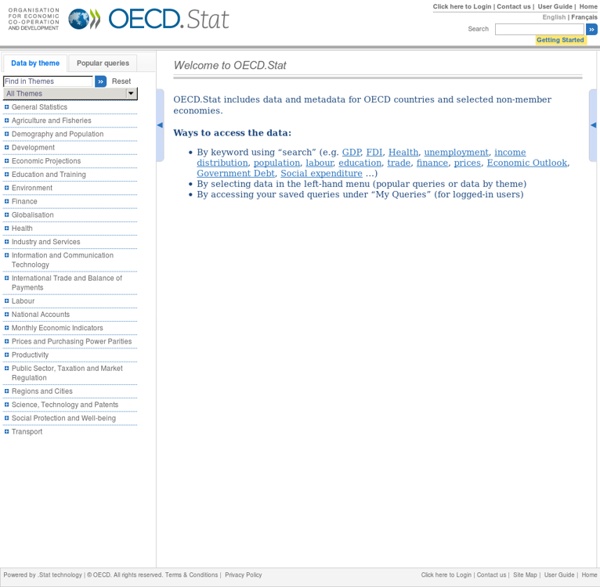



http://stats.oecd.org/Index.aspx
public data Indicateurs de développement humain Rapport sur le développement humain 2013, Programme des Nations Unies pour le développement Les données utilisées pour calculer l'Indice de développement humain (IDH) et autres indices composites présentés dans le Rapport sur le développement humain ... Eurostat, Indicateurs démographiques Eurostat Bases de données des Nations Unies UN Comtrade Interrogez les bases de données des statistiques sur le commerce des produits de base (Comtrade) qui stockent plus d'un milliard de données commerciales depuis 1962. Plus de 140 pays fournissent, à la Division des statistique des Nations Unies, leurs données annuelles détaillées du commerce international par produit et pays partenaires. Elles sont consultables dans la limite de 50 000 dossiers. Si vous souhaitez télécharger plus de données, abonnez-vous pour avoir un accès premium qui vous permettra également de personnaliser votre profil. [secteur privé, réglementation, échanges, importations, exportations, marchés, tendances] ReliefWeb - Bureau de la coordination des affaires humanitaires (BCAH) ReliefWeb est votre source d'information humanitaire en temps opportun, fiable, pertinente et d'analyse. Son objectif est de vous aider à donner du sens à des crises humanitaires dans le monde entier.
Indicadores ODM & Desenvolvimento - Indicators This page in: Indicators Agriculture & Rural Development Aid Effectiveness Climate Change Climate Change Knowledge Portal International Monetary Fund The International Monetary Fund (IMF) is an international organization headquartered in Washington, D.C., of "188 countries working to foster global monetary cooperation, secure financial stability, facilitate international trade, promote high employment and sustainable economic growth, and reduce poverty around the world."[1] Formed in 1944 at the Bretton Woods Conference, it came into formal existence in 1945 with 29 member countries and the goal of reconstructing the international payment system. Countries contribute funds to a pool through a quota system from which countries experiencing balance of payments difficulties can borrow money. As of 2010[update], the fund had XDR476.8 billion, about US$755.7 billion at then-current exchange rates.[4]
ited Nations Millennium Development Goals The eight Millennium Development Goals (MDGs) – which range from halving extreme poverty rates to halting the spread of HIV/AIDS and providing universal primary education, all by the target date of 2015 – form a blueprint agreed to by all the world’s countries and all the world’s leading development institutions. They have galvanized unprecedented efforts to meet the needs of the world’s poorest. The UN is also working with governments, civil society and other partners to build on the momentum generated by the MDGs and carry on with an ambitious post-2015 development agenda. News on Millennium Development Goals ited Nations Statistics Division New York, 1 June 2016 - The chair of the Statistical Commission, Ms. Wasmalia Bivar of Brazil, addressed the Economic and Social Council (ECOSOC) on 1 June during its Coordination and Management Meeting. Ms. Bivar, who provided her briefing by videolink, informed the Council that the Statistical Commission at its last session in March had agreed “as a practical starting point” on a global indicator framework, which had been developed by the Inter-agency and Expert Group on Sustainable Development Goal Indicators (IAEG-SDGs). She also informed the Council of the recent work of the High-level Group for Partnership, Coordination and Capacity-Building for statistics for the 2030 Agenda for Sustainable Development and the plans for a first UN World Data Forum to be held in Capetown, South Africa, in January 2017. The presentation (English, Spanish) was followed by a short Q&A session.
Indicadores ODM & Desenvolvimento - UN: Global poverty rate is decreasing but progress is yet to be felt by the most vulnerable in society - Eurostep The UN launched its annual report on the state of progress of the Millennium Development Goals (MDGs) this week. The report argues that whilst global poverty rates are falling, progress has been uneven and achievement of some of the MDGs is still lagging behind — particularly in the poorest nations. The UN Millennium Development Goals Report 2011 argues there has been huge success in many of the 8 goals.
COMET Welcome to the CoMET website CoMET is a programme of international railway benchmarking. It is made up of a consortium of large metro systems from around the world - Beijing, Berlin, Guangzhou, Hong Kong, London, Mexico City, Madrid, Moscow, New York, Paris, Santiago, Shanghai, Sao Paulo and Taipei. The four main objectives of CoMET are: Indicadores ODM & Desenvolvimento - Sanitation Sanitation is the hygienic means of promoting health through prevention of human contact with the hazards of wastes as well as the treatment and proper disposal of sewage wastewater. Hazards can be either physical, microbiological, biological or chemical agents of disease. Wastes that can cause health problems include human and animal feces, solid wastes, domestic wastewater (sewage, sullage, greywater), industrial wastes and agricultural wastes. Hygienic means of prevention can be by using engineering solutions (e.g. sewage and wastewater treatment), simple technologies (e.g. latrines, septic tanks), or even by personal hygiene practices (e.g. simple handwashing with soap).
Indicadores ODM & Desenvolvimento - Measuring poverty Map of world poverty by country, showing percentage of population living on less than $1.25 per day. Information is based on different years (2000-2006) for different countries. Data is missing for countries colored grey. The percentage of the world's population living on less than $1 per day has halved in 20 years. Most of this improvement has occurred in East and South Asia. The graph shows the 1981–2001 period. Open data An introductory overview of Linked Open Data in the context of cultural institutions. Clear labeling of the licensing terms is a key component of Open data, and icons like the one pictured here are being used for that purpose. Overview[edit]